Introduction:
Seed Cycling is a natural health practice that supports hormonal balance by cyclically including particular kinds of seeds in your diet. The idea behind seed cycling is that different kinds of seeds contain vitamins, minerals, and essential fatty acids that can help the body make and keep hormones like estrogen and progesterone in balance. Most people eat the whole seeds, add them to food or drinks, or take them as oil supplements. However, seed cycling is not a substitute for conventional medical treatment and there is insufficient scientific evidence to support its efficacy in maintaining hormonal balance.
What Does Seed Cycling Means And How To Do It?
It’s important to note that there isn’t much scientific evidence to suggest that seed cycling helps maintain hormonal balance, so it shouldn’t be used in place of traditional medical care. Before beginning any new health practice, it is best to talk to a doctor.
It is a natural health practice that supports hormonal balance by eating certain kinds of seeds at different times during a woman’s menstrual cycle. Essential fatty acids, vitamins, and minerals in the seeds used to help regulate the production and balance of hormones like estrogen and progesterone.
The following steps are typically taken during the process.
Menstrual cycle days 1 through 14: Ground flaxseed and pumpkin seeds, one tablespoon each, should be consumed daily. Omega-3 fatty acids and lignans found in these seeds support estrogen production.
Menstrual cycle days 15-28: Each day, consume 1 tablespoon of ground sesame and sunflower seeds. Omega-6 fatty acids and lignans found in these seeds support progesterone production.
Starting on the first day of your menstrual cycle, perform this cycle every month.
Seed Cycling: Does It Work?
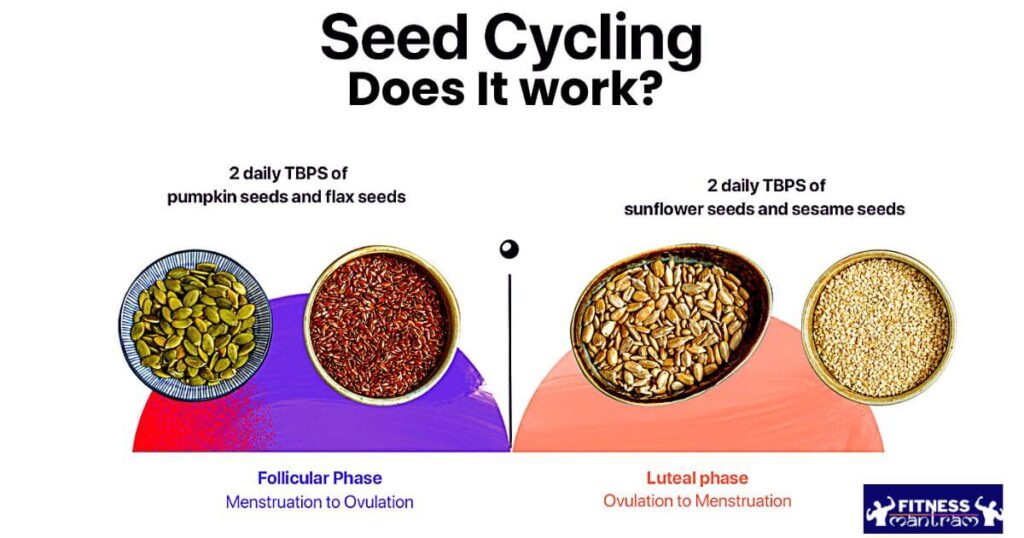
It is not clear whether this process as a natural way to maintain hormonal balance is effective. There is insufficient scientific evidence to support the claims made by proponents of seed cycling that it can help regulate hormone levels and alleviate symptoms like menstrual cramps, acne, and mood swings.
Anecdotal evidence and uncontrolled clinical studies do not support many of the suggested advantages of seed cycling. Seed cycling’s efficacy for hormonal balance is currently unsupported by rigorous scientific research.
It is essential to keep in mind that conventional medical treatment for hormonal imbalances and other health conditions should not be used in conjunction. It is best to see a doctor if you have symptoms that are caused by hormonal imbalances so that you can get the right diagnosis and treatment.
Seed Cycling Recipes
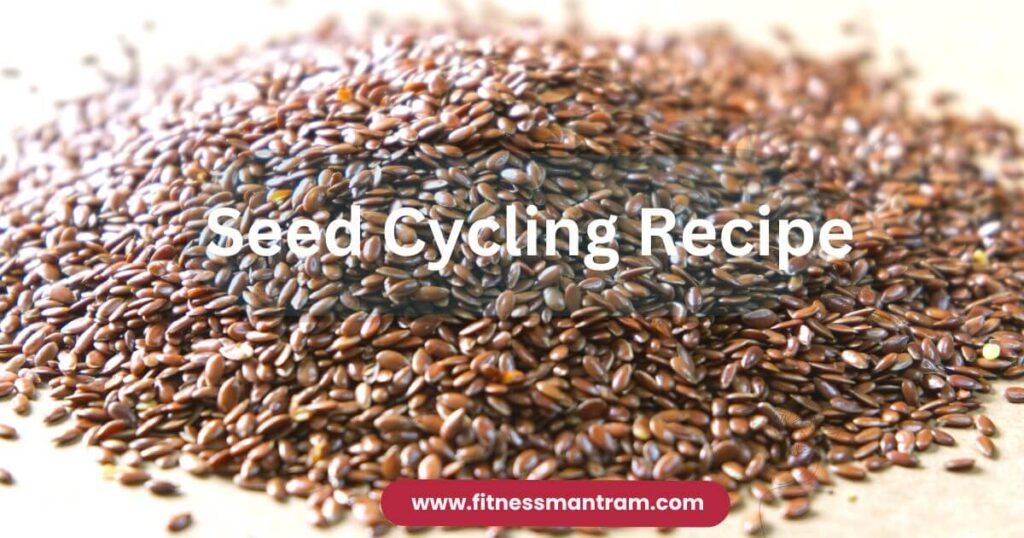
These are just suggestions; you can alter the quantities of the ingredients in them as you see fit. According to the principles the most important thing is to eat the kinds of seeds that are recommended for you on the right days of your menstrual cycle to help maintain hormonal balance.
You can try some easy recipes for seeds cycling
Smoothie with pumpkin seeds and flaxseed: Almond milk, frozen berries, a banana, one tablespoon each of ground flaxseed and pumpkin seed, and one scoop protein powder should be blended together.
Dressing for salad made with sunflower and sesame seeds: Olive oil, lemon juice, honey, salt, pepper, and one tablespoon of each ground sunflower and sesame seeds are all that are needed to make this dish.
Oatmeal with pumpkin seeds and flaxseeds: Oatmeal should be cooked according to the package’s directions. Add ground flaxseed and pumpkin seed, 1 tablespoon at a time, and any toppings you like, like honey, sliced fruit, or nuts.
Hummus made with sunflower and sesame seeds: Combine chickpeas, tahini, lemon juice, garlic, salt, and one tablespoon each of ground sesame seeds and sunflower seeds in a blender.
Granola made with pumpkin and flax seeds: Oats, nuts, dried fruit, maple syrup, and one tablespoon each of ground flaxseed and pumpkin seed are mixed into the mixture. Serve with yogurt or milk after baking until golden brown.
Benefits Of Seed Cycling
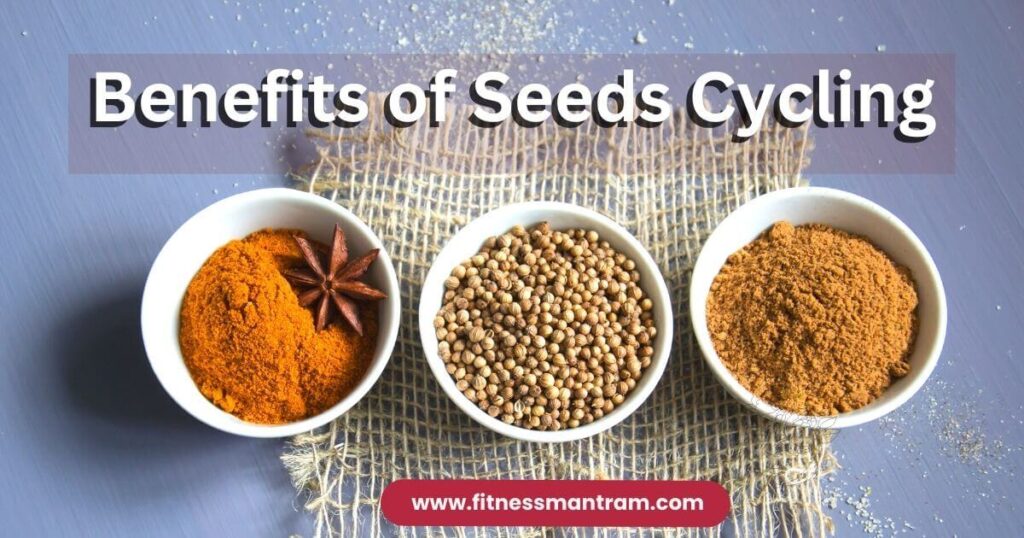
It is essential to keep in mind that the advantages of this process are not well-established by scientific evidence and may vary from individual to individual. It has not been thoroughly tested in controlled clinical studies for hormonal balance, so it should not be used in place of conventional medical treatment.
It is a natural health practice that involves consuming specific types of seeds during various phases of the menstrual cycle to support hormonal balance. If you are experiencing symptoms related to hormonal imbalances, it is best to consult a healthcare professional for an accurate diagnosis and appropriate treatment.
- Regulated levels of hormones: It is thought that eating various seeds can help keep hormones like estrogen and progesterone in balance and regulate their production.
- Improved menstrual symptoms: It is said that seed cycling helps with symptoms like menstrual cramps, bloating, and mood swings.
- A healthier complexion: It is thought that certain seeds’ lignans and omega-3 fatty acids can help improve skin health and alleviate acne symptoms.
- A surge of energy: Energy levels are said to rise when seeds, vitamins, minerals, and essential fatty acids are included in a balanced diet.
Seed Cycling For Fertility
It as a natural method of supporting fertility is sometimes promoted, but there is little scientific evidence to support this claim. It suggests that eating certain kinds of seeds at different times of the menstrual cycle can help keep hormone levels in check and improve overall reproductive health.
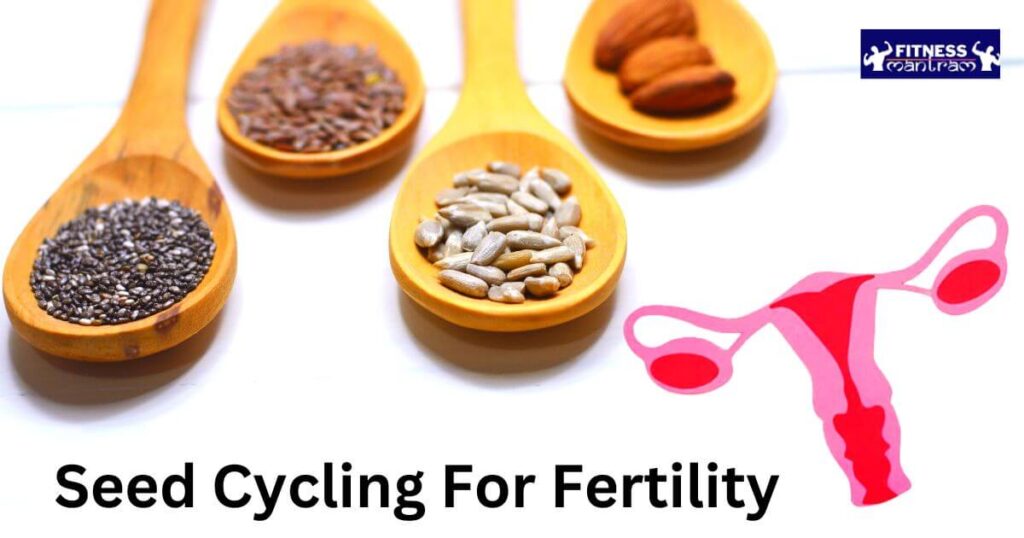
However, no controlled clinical studies have demonstrated that seed cycling is effective for increasing fertility. Additionally, there is a dearth of evidence to suggest that the recommended seed and nutrient combinations may have a significant effect on fertility.
If you’re trying to get pregnant but are having trouble, it’s best to talk to a doctor for a full evaluation and the right treatment. It should not be considered a substitute for conventional medical treatment because fertility issues can have a variety of underlying causes.
A healthy lifestyle, which includes eating a well-balanced diet, exercising regularly, and reducing stress, can support reproductive health in general. However, any new health practices should always be discussed with a healthcare professional first.
Side Effects Of Seed Cycling
It is a natural health practice that supports hormonal balance by eating certain kinds of seeds at different times during the menstrual cycle. The majority of people consider seed cycling to be risk-free, and adverse effects are uncommon.
However, when consuming a lot of seeds, some people may experience gastrointestinal symptoms like bloating, gas, and diarrhea. By gradually increasing the amount of seeds consumed and by drinking plenty of water, these symptoms can typically be reduced.
Additionally, it is essential to be aware of any food sensitivities or allergies prior to beginning seed cycling because some individuals may have an intolerance or allergy to particular seeds.
Last but not least, it’s important to remember that eating too many seeds can cause an imbalance of essential fatty acids, which can be bad for your health as a whole. It is suggested that you adhere to the guidelines for seed cycling and not grow more than what is recommended.
Most people think that seed cycling is a safe natural health practice overall. However, before continuing with seed cycling or beginning any new health practices, it is best to consult a healthcare professional if you have any concerns or experience adverse effects.
Seed Cycling For Menopause
It as a natural way to support hormone balance during menopause is sometimes promoted. According to proponents of seed cycling for menopause, consuming particular varieties of seeds during various phases of the menstrual cycle can help regulate hormone levels and alleviate symptoms like night sweats, mood swings, and hot flashes.
However, no controlled clinical studies have proven that seed cycling relieves menopause symptoms. There isn’t much evidence to suggest that the specific seed and nutrient combinations recommended for seed cycling can have a big effect on menopausal hormone levels.
It is best to see a doctor if you are experiencing menopausal symptoms so that you can get the right diagnosis and treatment. Seed cycling should not be used in place of traditional medical care because hormonal imbalances during menopause can have a variety of underlying causes.
During menopause, a healthy lifestyle that includes eating a well-balanced diet, exercising regularly, and reducing stress can generally support overall health. However, any new health practices should always be discussed with a healthcare professional first.
Seed Cycling Success Stories
There are a lot of anecdotal accounts of people who say they’ve seen improvements in their menstrual symptoms, hormone levels, and skin health. However, it is essential to keep in mind that these reports may not be representative of the general population and lack scientific rigor.
The results can vary greatly from person to person based on a variety of factors, such as diet, lifestyle, and overall health. Additionally, there is a possibility that the reported advantages are the result of a so-called “placebo effect,” as modifying one’s diet and way of life frequently results in improved symptoms.
It is also essential to keep in mind that seed cycling should not be used in place of conventional medical treatment because many hormonal imbalances can have a variety of underlying causes. It is best to see a doctor if you are experiencing symptoms that are caused by hormonal imbalances in order to get an accurate diagnosis and the right treatment.
It is best to approach this natural health practice with caution and in consultation with a healthcare provider because, in general, the success of seed cycling will depend on many individual factors.
Conclusion:
It is a natural health practice that supports hormonal balance by eating particular kinds of seeds during various menstrual cycles. Seed cycling’s positive anecdotal reports are numerous, but there is little scientific evidence to support its efficacy.
It is essential to note that this process should not be regarded as an alternative to standard medical treatment, and individuals should always seek the advice of a healthcare professional prior to beginning any new health practices.
A healthy lifestyle, which includes eating a well-balanced diet, exercising regularly, and reducing stress, can support overall health and hormone balance. Although there are some advantages, it should be done with caution and in consultation with a medical professional.
Frequently Asked Questions:
For how long should seed cycling be performed?
It cannot be performed for a predetermined amount of time. Some people choose to use seed cycling as a short-term fix for specific problems with their menstrual cycle, while others make it a permanent part of their daily routine.
Before beginning, it’s important to talk to a doctor, especially if you have a medical condition or are taking medication. It should not be considered a substitute for conventional medical treatment because some hormonal imbalances may have underlying causes that need to be addressed.
In addition, it is essential to keep in mind that seed cycling is not a one-size-fits-all solution and that the level of success achieved by this method can greatly depend on a person’s diet, lifestyle, and overall health.
In general, this process should be continued as long as it is beneficial to your health and well-being, but only after consulting a medical professional.
Does seed cycling aid in hormone regulation?
Consuming particular kinds of seeds during various phases of the menstrual cycle is a natural health practice that is promoted as a means of balancing hormones. It proponents contend that certain seed and nutrient combinations can regulate hormones, alleviate menstrual symptoms, and boost overall health.
However, there is not a lot of scientific evidence to suggest that this is effective for maintaining hormone balance. Although some seeds contain omega-3 fatty acids, lignans, and phytoestrogens, which are essential for hormonal balance and overall health, the recommended combinations and amounts for seed cycling have not been thoroughly investigated.
Additionally, conventional medical treatment is frequently the most effective way to address hormonal imbalances, which can have a variety of underlying causes. It is not a substitute for traditional medical care, and it is essential to seek the advice of a medical professional in order to receive an accurate diagnosis and the most suitable treatment.
A healthy lifestyle, which includes eating a well-balanced diet, exercising regularly, and reducing stress, can support overall health and hormone balance. Although it may have some advantages, it should be done with caution and in consultation with a medical professional.
How to consume seeds for seed cycling
It is when you eat certain kinds of seeds at different times during your menstrual cycle.
Consuming seeds for seed cycling is as follows
Follicular Phase: From Day 1 through 14 of the menstrual cycle: Ground pumpkin seeds and flax seeds should be consumed daily during this phase, about one to two tablespoons each. Omega-3 fatty acids and lignans, which help maintain hormonal balance, are abundant in these seeds.
Menstrual Luteal Phase (from Day 15 to Day 28): Ground sesame seeds and sunflower seeds, one to two tablespoons each, should be consumed daily during this phase. These seeds are rich in phytoestrogens and lignans, both of which can help regulate hormones and alleviate symptoms of menstruation.
Because whole seeds are difficult to digest and may not provide the same benefits as ground seeds, it is essential to grind the seeds prior to consumption. The ground seeds can be mixed into your favorite recipes, added to smoothies, or sprinkled on top of meals.
Before beginning seed cycling, it’s also important to talk to a doctor, especially if you have a medical condition or are taking medication. Seed cycling should not be considered a substitute for conventional medical treatment because some hormonal imbalances may have underlying causes that need to be addressed.
Read More
- Art Of Skin Care –The Science Of Beautiful Skin
- Carnivore Diet Meal Plan- Why Doesn’t Work For Everyone
- Nude Yoga : The Benefits and Challenges of Nude Yoga
- Tea Burn – The Truth About Tea Burn In 3 Minutes
- Gluconite : The Secret of GLUCONITE Is Revealed
Disclaimer : The details & information given here in this article is based on information as available on other published site on internet. Do take medical advice before adopting it. Fitness Mantram Does Not Confirm It. This site contains affiliate links. If you choose to make a purchase after clicking a link the author/owner/creator may receive a commission at no ADDITIONAL cost to you. Thank you for your support.
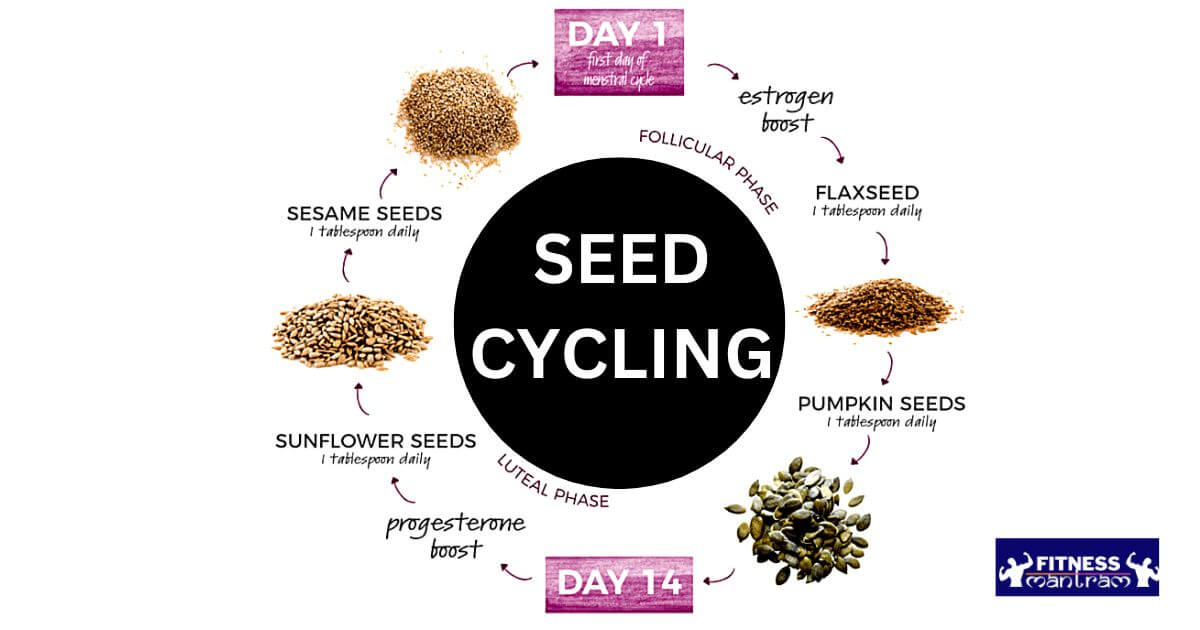
3 thoughts on “Seed Cycling- The Next Step For Fertility”